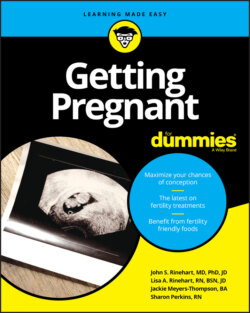Читать книгу Getting Pregnant For Dummies - Sharon Perkins - Страница 58
Recognizing signs of ovulation
ОглавлениеIt normally takes between 10 and 14 days to mature a good egg and release it, so if you have 28- to 30-day cycles, you may ovulate sometime between day 14 and day 16 of your cycle. Shorter cycles have an earlier ovulation day, and longer cycles a later ovulation day. How do you know if you’ve ovulated? Some women experience a sharp pain when they ovulate, called mittelschmertz, or have a vaginal discharge; however, these symptoms are very subjective and are not reliable indicators of ovulation. A more reliable method is correctly using an ovulation predictor kit. That said, you may be able to tell that you’re ovulating in a few simple ways, just by watching the calendar and being observant about your bodily functions.
Usually the mucus from your cervix increases around the time of ovulation. It also becomes very thin, clear, and stretchy; you can easily stretch it out a couple of inches. Rising estrogen levels from a developing follicle create this mucus, which is easier for sperm to swim through than your usual thicker mucus and also has an alkaline pH, which helps the sperm live longer. At other times of the month, cervical mucus is acidic. Be sure that you’re not confusing cervical mucus with semen from previous sex or increased secretions from sexual arousal.
If you have no objection to feeling around inside your vagina, you’ll also notice that your cervix becomes softer, slightly open, and easier to locate with your fingers when you’re about to ovulate. At other times of the month, the cervix is found farther back in the uterus, feels firmer to the touch, and is tightly closed.
About 20 percent of women have pain called mittelschmertz (German for “middle pain”) when they ovulate. The pain seems to be caused by blood and fluid released from the ruptured follicle irritating the tissues around the ovary. Sometimes a small amount of vaginal bleeding occurs with ovulation, too.
Some women have headaches around the time of ovulation, and others complain of bloating or breast pain. You’re probably already aware of your personal ovulation indicators, but you may have just never paid much attention to them; just don’t be disappointed if you don’t have these symptoms — that doesn’t mean you are not ovulating!
Paying attention to when you ovulate is okay but unnecessary. If a woman has regular cycles every 28–32 days, she will ovulate around midcycle. If the goal is to get pregnant through intercourse, then having intercourse every other day around mid-cycle will maximize the chance of getting pregnant. You can have intercourse more frequently if you want. You do not need to worry that you are having too much intercourse. Men do not improve their chances for conception by storing sperm. They aren’t stored in the man’s body — in fact they die and are removed.
